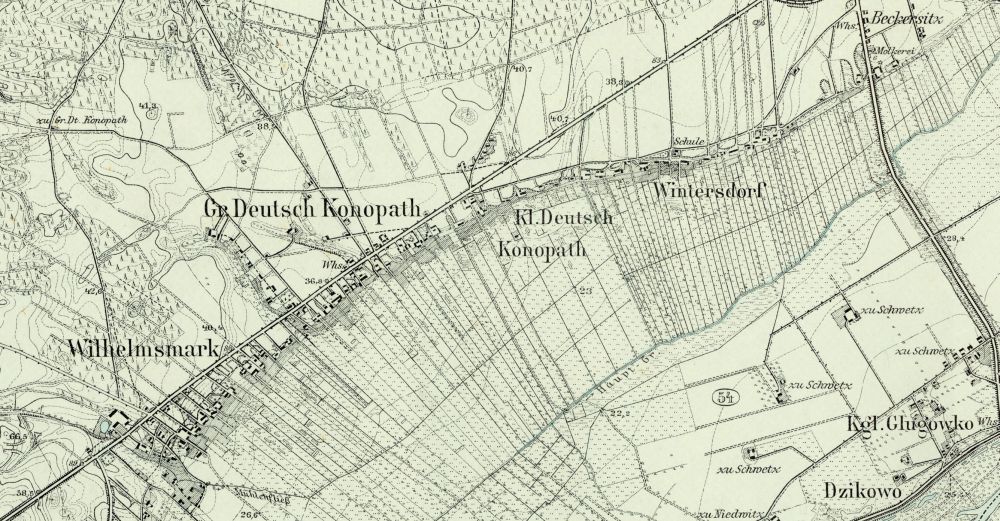Before we move on to the third list in the Deutsch-Wymysle church records, we should probably close the book on the correspondences between the 1810 Schwetz-area census and the Deutsch-Wymysle material.
Looking through the list of people who came to Deutsch-Wymsyle, one can easily spot those who were born before 1810 (when the census was taken) and who came from the Schwetz area. A total of fourteen people fit that profile. The question then becomes how many of them can also be identified on the 1810 census posted here.
1. We concluded in the previous post that Helene Buller Nachtigall should be identified with Helena Buller daughter of Jacob and Maria Buller of Ostrower Kämpe. We also noted that neither the parents nor Helene’s older sisters appear in the church records.
2. Another resident of Ostrower Kämpe seems to appear in both records as well: Helene Nachtigal, the daughter of Jacob and Sara. The years of birth do not agree between the two lists, but since the dates are reasonably close and there was no other Nachtigal family in Ostrower Kämpe at this time, the identification of the two is reasonable. GRANDMA agrees that both records refer to the same person (number 11 in the database).
Worth noting is that Helene married Jacob Foth shortly after the census, on 4 August 1810. If the Deutsch-Wymysle records have her birth year correct, she was seventeen at the time. In light of the fact that Helene and Jacob’s first four children were born in Ostrower Kämpe (the latest in 1819), we know that they moved to Deutsch-Wymysle sometime after that.
3. Peter Frey, the thirteen-year-old son of Peter and Eva Frey of Glugowko in the 1810 census, is almost certainly the Peter Frey born in late 1796 in the same village according to the church records. GRANDMA agrees with the identification (number 35845). Peter the elder died in 1813, and we do not know when his mother died—or when Peter Jr. moved to Deutsch-Wymysle, except that it was sometime before 1822, when he married Anna Janzen of Brenkenhoffswalde (i.e., since they came from different areas, they presumably met only when both were in Deutsch-Wymysle).
4. Heinrich Unruh of Przechowka (according to the census), the ten-year-old son of Johan and Maria, is quite likely the Heinrich Unruh born 18 June 1799 in Deutsch Konopath, according to the Deutsch-Wymysle records (note the close proximity of Deutsch Konopath and Wintersdorf, aka Przechowka, in the map to the right). Heinrich moved to Deutsch-Wymysle sometime before 1819, when he married Susanna Buller of Brenkenhoffswalde at Deutsch-Wymysle. GRANDMA agrees that both records refer to the same person (number 41999).
5. Jacob Raztlaff, nine-year-old son of Jacob and Maria of Przechowka in the 1810 census, is likely the same as the boy born in early 1802 in Deutsch Konopath (GRANDMA agrees: number 47848). He emigrated to Deutsch-Wymysle sometime before 1827, when we was married there. How much before is unknown, although one should note that Jacob Jr. is the only member of his family listed in the Deutsch-Wymysle church records.
6. Finally, Elisabeth Pankratz of Beckersitz, daughter of Andreas and Maria, was seven years old in 1810, so born in 1803, just like the Elisabeth Pankratz of Przechowka, per the church records. Once again, GRANDMA agrees that the two lists are referring to the same person (number 25013). What is interesting in this case is that Elisabeth’s husband Peter was born in Frantal in the Neumark area. He presumably moved first to Przechowka, where he married Elisabeth. Their first three children were born in Przechowka (through 1829), so they no doubt moved to Deutsch-Wymysle sometime between then and 1837, when their fourth child was born in Deutsch-Wymysle.
What (if anything) have we learned through this brief exercise?
First, the fact that six of the fourteen possibilities (43 percent) from the Deutsch-Wymysle list can be identified in the 1810 census is rather remarkable. Recall that the church records merely recorded the place of birth; it may well be tht a number of individuals who had been born in the Schwetz region had relocated before 1810 and thus would not appear in that particular census. Viewed in this light, the two records evidence a close correspondence.
Second, our earlier impression that much of the emigration to Deutsch-Wymysle took place in the 1810s and 1820s is bolstered by what we find here. Further, when we look more closely at the eight people from the church records whom we could not find on the 1810 census (for whatever reason), we discover that those who can be tracked down likewise relocated to Deutsch-Wymysle in the late 1810s or later. In other words, thus far we have found no evidence to support the common belief that emigration to Deutsch-Wymysle began in the last decades of the eighteenth century; in fact, all of the evidence thus far places the beginning of emigration no earlier than the 1800s and more likely in the 1810s and later.
Not much else to wring from this excursion, so we will move forward to Deutsch-Wymysle list 3 in the next post. We will also return at some point in the near future to our own direct ancestors. It will have been worth the wait, since there is new information about David and Benjamin Buller to report.
Note
For anyone who wants to check the six individuals discussed above in the sources, I list them all here for your convenience (Deutsch-Wymysle list 1 number, GRANDMA number, Przechowka church book number):
1. Helene Buller: DW 126, GM 30459, PCB 1513
2. Helene Nachtigal: DW 46, GM 11, PCB —
3. Peter Frey: DW 64, GM 35845, PCB —
4. Heinrich Unruh: DW 208, GM 41999, PCB 1373
5. Jacob Raztlaff: DW 166, GM 47848, PCB 1417
6. Elisabeth Pankratz: DW 187, GM 25013, PCB 1435

No comments:
Post a Comment